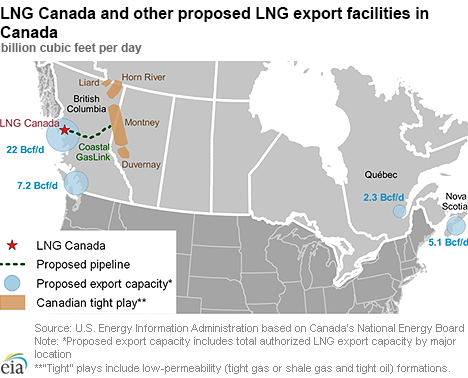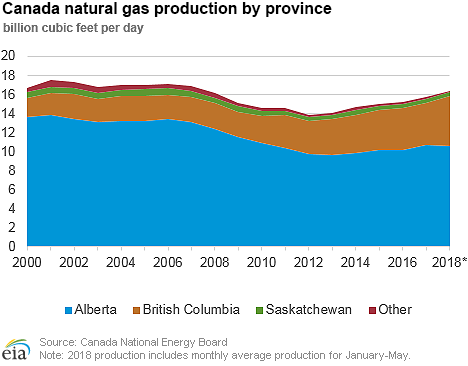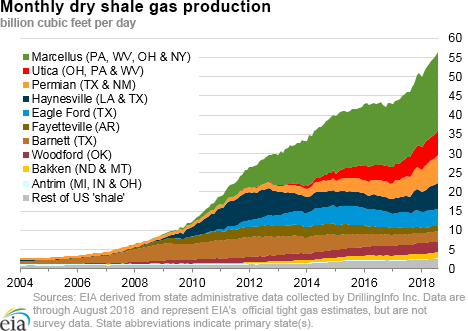In the News:
LNG Canada becomes first major liquefaction export project in Canada to reach Final Investment Decision
On October 1, 2018, LNG Canada became the first among the proposed liquefied natural gas (LNG) export projects in Canada to reach Final Investment Decision (FID) and the first large-scale greenfield liquefaction facility to be built on the west coast of the North American continent.
LNG Canada will have two liquefaction units, called trains, with a combined capacity of 14 million metric tons per annum (1.8 billion cubic feet per day (Bcf/d)), expandable to four trains. The facility will be located in Kitimat, on the Pacific coast of British Columbia in western Canada, and will be supplied by natural gas from the Montney formation, which straddles British Columbia and Alberta, via a proposed 2.1 Bcf/d, 420 mile-long Coastal GasLink pipeline to be built by TransCanada.
The project is a joint venture between Royal Dutch Shell (which holds a 40% stake in the project), Petronas (25%), Mitsubishi (15%), PetroChina (15%), and Korea Gas (5%). This project made an FID without first securing long-term Sales and Purchase Agreements (SPAs) with LNG buyers, which are typically required by financial institutions to fund large-scale liquefaction facilities. Instead, project developers will arrange their own financing, and each of the project partners will be responsible for providing natural gas supply for liquefaction and marketing its own share of off-take LNG volumes.
Growing natural gas production in western Canada from abundant shale and tight natural gas resources, as well as declining pipeline exports to the United States since 2010, have prompted Canadian producers to seek new markets for natural gas. More than 30 LNG export projects have been proposed, primarily in western Canada. To date, Canada’s National Energy Board (NEB) has authorized 18 LNG export projects. Of these projects, 13 are authorized in British Columbia on the west coast and 5 in Nova Scotia and Quebec on the east coast, with a combined export capacity of 36.6 Bcf/d. The duration of export licenses issued by NEB for these projects ranges from 20 years to 40 years.
Overview:
(For the Week Ending Wednesday, October 10, 2018)
- Natural gas spot price movements rose at most locations this report week (Wednesday, October 3 to Wednesday, October 10). Henry Hub spot prices rose from $3.26 per million British thermal units (MMBtu) last Wednesday to $3.37/MMBtu yesterday.
- At the New York Mercantile Exchange (Nymex), the November 2018 contract price rose 5¢ from $3.230/MMBtu last Wednesday to $3.284/MMBtu yesterday.
- Net injections to working gas totaled 90 billion cubic feet (Bcf) for the week ending October 5. Working natural gas stocks are 2,956 Bcf, which is 17% lower than the year-ago level and 17% lower than the five-year (2013–17) average for this week.
- The natural gas plant liquids composite price at Mont Belvieu, Texas, fell by 73¢, averaging $10.07/MMBtu for the week ending October 10. The price of natural gasoline, ethane, propane, butane, and isobutane fell by 1%, 16%, 3%, 6%, and 7%, respectively.
- According to Baker Hughes, for the week ending Tuesday, October 2, the natural gas rig count remained flat at 189. The number of oil-directed rigs fell by 2 to 861. The total rig count decreased by 2, and it now stands at 1,052.
Prices/Supply/Demand:
The national benchmark average spot price increases for the fourth straight week. This report week (Wednesday, October 3 to Wednesday, October 10), Henry Hub spot prices rose 11¢ from $3.26/MMBtu last Wednesday to $3.37/MMBtu yesterday. This week marks the fourth week of a Henry Hub price increase; during this period the Henry Hub spot price rose 15%.
Persistent low storage levels, coupled with high power burn because of warmer-than-normal temperatures and record nuclear outages, have contributed to higher Henry Hub prices. At the Chicago Citygate, prices increased 19¢ from $3.18/MMBtu last Wednesday to $3.37/MMBtu yesterday. Prices at PG&E Citygate in Northern California rose 27¢, up from $3.50/MMBtu last Wednesday to $3.77/MMBtu yesterday. Prices at SoCal Citygate decreased 75¢ from $4.42/MMBtu last Wednesday to $3.67/MMBtu yesterday.
Northeast prices decrease. At the Algonquin Citygate, which serves Boston-area consumers, prices went down 55¢ from $3.60/MMBtu last Wednesday to $3.05/MMBtu yesterday. At the Transcontinental Pipeline Zone 6 trading point for New York City, prices decreased 36¢ from $3.29/MMBtu last Wednesday to $2.93/MMBtu yesterday.
Appalachian prices increase. Tennessee Zone 4 Marcellus spot prices increased 90¢ from $1.92/MMBtu last Wednesday to $2.82/MMBtu yesterday. Prices at Dominion South in southwest Pennsylvania rose 69¢ from $2.09/MMBtu last Wednesday to $2.78/MMBtu yesterday.
Discount at key Permian Basin trading hub persists. Prices at the Waha Hub in West Texas, which is located near Permian Basin production activities, averaged $1.04/MMBtu last Wednesday, $2.22 lower than Henry Hub prices. Yesterday, prices at the Waha Hub averaged $1.76/MMBtu, $1.61 lower than Henry Hub prices.
Enbridge Westcoast Transmission System pipeline explosion causes natural gas flow disruption to Washington. An explosion on a 36-inch pipeline on October 9, 2018 in Prince George, British Colombia, Canada cut off an estimated 1 Bcf/d of natural gas imports from Canada to Washington. Following the explosion, the operator of the pipeline, Enbridge, obtained approval from the Canadian National Energy Board, to restart a parallel 30-inch line on the same right of way as the 36-inch line. In Washington, Puget Sound Energy issued a notice to customers to conserve natural gas by lowering thermostats and limiting hot water use. With Westcoast pipeline utilization rates at zero, very little natural gas crossed the Canada-Washington border at the Sumas gate, causing prices at that location to fall from $2.87/MMBtu to $0 from last Wednesday to yesterday.
Hurricane Michael made landfall in the Florida panhandle. On October 10, the category 4 storm hurricane Michael made landfall in the Florida panhandle. The Bureau of Safety and Environmental Enforcement reported that 812 million cubic feet per day (MMcf/d) (32%) of the natural gas production in the Gulf of Mexico was shut-in in anticipation of the hurricane. As of 6 pm, October 10, about 388,000 customers in Florida, roughly 3.7% of the state’s population, are expected to have electricity outages. Natural gas is a major source of electricity generation in Florida, and in 2017 two-thirds of Florida’s net electricity generation came from natural gas.
Nymex futures increase. At the Nymex, the price of the November 2018 contract increased 5¢, from $3.230/MMBtu last Wednesday to $3.284/MMBtu yesterday. The price of the 12-month strip averaging November 2018 through October 2019 futures contracts climbed 4¢ to $2.968/MMBtu.
Supply remains flat. According to data from PointLogic Energy, the average total supply of natural gas remained the same as in the previous report week, averaging 91.1 Bcf/d. Dry natural gas production also remained constant week over week. Average net imports from Canada increased by 2% from last week.
Demand increases with higher power generation. Total U.S. consumption of natural gas rose by 1% compared with the previous report week, according to data from PointLogic Energy. Natural gas consumed for power generation climbed by 4% week over week. Industrial sector consumption decreased by 2% week over week. In the residential and commercial sectors, consumption declined by 1%. Natural gas exports to Mexico decreased 3%.
U.S. LNG exports are flat week over week. Four LNG vessels (all from the Sabine Pass liquefaction terminal) with a combined LNG-carrying capacity of 15 Bcf departed the United States from October 4 to October 10. One tanker (LNG-carrying capacity 3.8 Bcf) was loading at Sabine Pass on Wednesday. There were no LNG exports from the Cove Point liquefaction terminal last week and no natural gas feedstock deliveries by pipeline as the facility continues its scheduled maintenance.
Freeport LNG, another U.S. liquefaction facility currently under construction, received a partial LNG cargo on September 17, according to Bloomberg ship tracking data. This LNG will be stored in the facility’s cryogenic storage tanks until liquefaction equipment is ready for testing as part of commissioning activities. The cargo was sourced from Trinidad and Tobago and was partially offloaded at Brazil’s Guanabara Bay import terminal prior to arriving to Freeport. The first export cargo from Freeport LNG is expected by mid-next year.
Storage:
Net injections match the five-year average. Net injections into storage totaled 90 Bcf for the week ending October 5, which is the same as the five-year (2013–17) average net injections and higher than last year's net injections (81 Bcf) during the same week. Working gas stocks totaled 2,956 Bcf, which is 607 Bcf lower than the five-year average and 627 Bcf lower than last year at this time.
Working gas stocks’ deficit to the five-year average remains unchanged, but the deficit to the bottom of the five-year range increases. The average rate of net injections into storage is 14% lower than the five-year average so far in the 2018 refill season (April through October). If the rate of injections into working gas matched the five-year average of 9.7 Bcf/d for the remainder of the refill season, total inventories would be 3,208 Bcf on October 31, which is 607 Bcf lower than the five-year average of 3,815 Bcf. In the Lower 48 states, total working gas stocks are currently 276 Bcf lower than the five-year minimum, and every storage region is currently near or lower than the bottom of the five-year range. As of this report week, the Midwest region is 84 Bcf (9%) lower than the five-year minimum, and the South Central region―including both salt and non-salt facilities―is 98 Bcf (10%) lower than the five-year minimum.
The average January 2019 futures contract price is trading at a lower premium to the average spot price than last year at this time. Price differences between the spot price and the futures price at the Nymex indicate limited economic incentives for injections into working gas. During the most recent storage week, the average natural gas spot price at the Henry Hub was $3.16/MMBtu, 3¢/MMBtu higher than the front-month futures price at the Nymex. A year ago, the spot price was 13¢/MMBtu lower than the front-month contract.
Reported net injections into storage are in the range of analysts’ expectations. According to The Desk survey of natural gas analysts, estimates of the weekly net change from working natural gas storage ranged from net injections of 74 Bcf to 97 Bcf, with a median estimate of 91 Bcf. At the 10:30 a.m. release of the Weekly Natural Gas Storage Report, the price of the Nymex futures contract for November delivery at the Henry Hub remained essentially unchanged at $3.19/MMBtu, with only 26 trades executed. The price varied somewhat in subsequent trading, falling to about $3.18/MMBtu.
Temperatures were significantly warmer than normal for the storage week. Temperatures in the Lower 48 states averaged 66 degrees Fahrenheit (°F), 4°F higher than normal and 2°F higher than last year at this time. Temperatures were 2°F lower than those reported for the previous week.
See also:
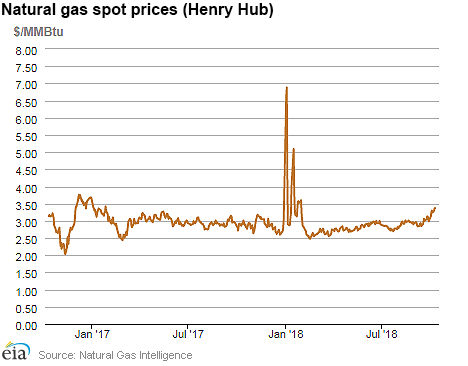
| Spot Prices ($/MMBtu) | Thu, 04-Oct |
Fri, 05-Oct |
Mon, 08-Oct |
Tue, 09-Oct |
Wed, 10-Oct |
|---|---|---|---|---|---|
| Henry Hub |
3.30 |
3.25 |
3.30 |
3.37 |
3.37 |
| New York |
2.76 |
1.53 |
2.79 |
2.86 |
2.93 |
| Chicago |
3.03 |
2.90 |
3.16 |
3.27 |
3.37 |
| Cal. Comp. Avg.* |
2.96 |
2.80 |
3.08 |
3.16 |
3.44 |
| Futures ($/MMBtu) | |||||
| November contract | 3.165 |
3.143 |
3.267 |
3.266 |
3.284 |
| December contract |
3.221 |
3.188 |
3.289 |
3.298 |
3.332 |
| *Avg. of NGI's reported prices for: Malin, PG&E Citygate, and Southern California Border Avg. | |||||
| Sources: Natural Gas Intelligence and CME Group as compiled by Bloomberg, L.P. | |||||
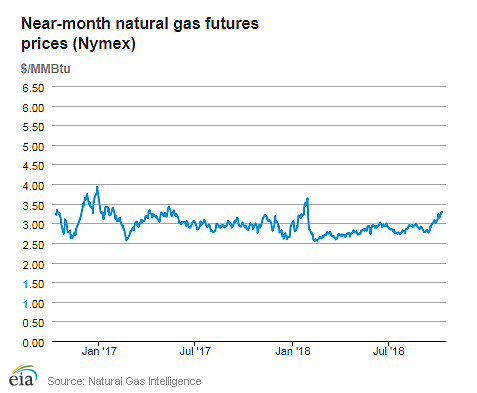
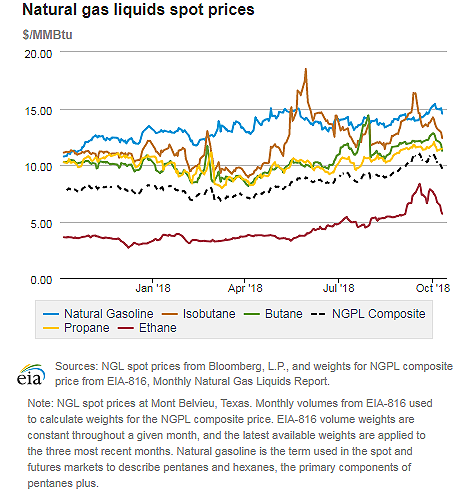
| U.S. natural gas supply - Gas Week: (10/4/18 - 10/10/18) | |||
|---|---|---|---|
Average daily values (Bcf/d): |
|||
this week |
last week |
last year |
|
| Marketed production | 96.4 |
96.3 |
82.3 |
| Dry production | 85.9 |
85.7 |
74.6 |
| Net Canada imports | 5.1 |
5.1 |
5.7 |
| LNG pipeline deliveries | 0.1 |
0.1 |
0.0 |
| Total supply | 91.1 |
90.8 |
80.3 |
|
Source: OPIS PointLogic Energy, an IHS Company | |||
| U.S. natural gas consumption - Gas Week: (10/4/18 - 10/10/18) | |||
|---|---|---|---|
Average daily values (Bcf/d): |
|||
this week |
last week |
last year |
|
| U.S. consumption | 63.8 |
62.9 |
59.4 |
| Power | 30.9 |
29.6 |
28.6 |
| Industrial | 21.0 |
21.3 |
21.2 |
| Residential/commercial | 11.8 |
11.9 |
9.5 |
| Mexico exports | 4.7 |
4.8 |
4.2 |
| Pipeline fuel use/losses | 7.0 |
6.9 |
6.5 |
| LNG pipeline receipts | 2.7 |
2.9 |
2.6 |
| Total demand | 78.2 |
77.5 |
72.7 |
|
Source: OPIS PointLogic Energy, an IHS Company | |||
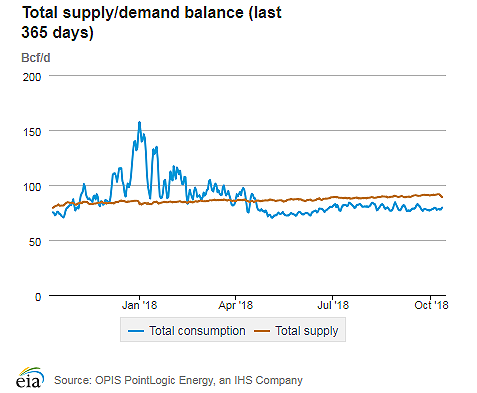
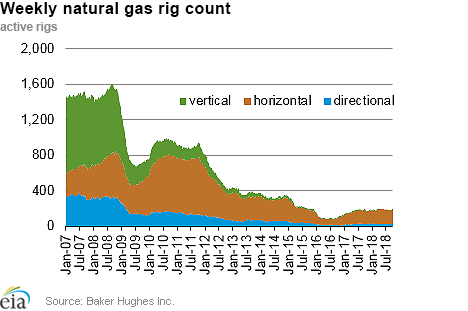
| Rigs | |||
|---|---|---|---|
Tue, October 02, 2018 |
Change from |
||
last week |
last year |
||
| Oil rigs | 861 |
-0.2% |
15.1% |
| Natural gas rigs | 189 |
0.0% |
1.1% |
| Note: Excludes any miscellaneous rigs | |||
| Rig numbers by type | |||
|---|---|---|---|
Tue, October 02, 2018 |
Change from |
||
last week |
last year |
||
| Vertical | 67 |
6.3% |
3.1% |
| Horizontal | 919 |
-0.3% |
16.0% |
| Directional | 66 |
-4.3% |
-16.5% |
| Source: Baker Hughes Inc. | |||
| Working gas in underground storage | ||||
|---|---|---|---|---|
Stocks billion cubic feet (Bcf) |
||||
| Region | 2018-10-05 |
2018-09-28 |
change |
|
| East | 790 |
763 |
27 |
|
| Midwest | 871 |
836 |
35 |
|
| Mountain | 180 |
177 |
3 |
|
| Pacific | 262 |
262 |
0 |
|
| South Central | 854 |
829 |
25 |
|
| Total | 2,956 |
2,866 |
90 |
|
| Source: Form EIA-912, "Weekly Underground Natural Gas Storage Report" | ||||
| Working gas in underground storage | |||||
|---|---|---|---|---|---|
Historical comparisons |
|||||
Year ago (10/5/17) |
5-year average (2013-2017) |
||||
| Region | Stocks (Bcf) |
% change |
Stocks (Bcf) |
% change |
|
| East | 881 |
-10.3 |
869 |
-9.1 |
|
| Midwest | 1,019 |
-14.5 |
1,004 |
-13.2 |
|
| Mountain | 223 |
-19.3 |
210 |
-14.3 |
|
| Pacific | 314 |
-16.6 |
340 |
-22.9 |
|
| South Central | 1,146 |
-25.5 |
1,139 |
-25.0 |
|
| Total | 3,583 |
-17.5 |
3,563 |
-17.0 |
|
| Source: Form EIA-912, "Weekly Underground Natural Gas Storage Report" | |||||
| Temperature – heating & cooling degree days (week ending Oct 04) | ||||||||
|---|---|---|---|---|---|---|---|---|
HDD deviation from: |
CDD deviation from: |
|||||||
| Region | HDD Current |
normal |
last year |
CDD Current |
normal |
last year |
||
| New England | 47 |
-20 |
-14 |
0 |
-1 |
-4 |
||
| Middle Atlantic | 20 |
-35 |
-26 |
4 |
0 |
2 |
||
| E N Central | 44 |
-14 |
7 |
12 |
7 |
4 |
||
| W N Central | 79 |
22 |
41 |
12 |
4 |
2 |
||
| South Atlantic | 0 |
-25 |
-20 |
76 |
34 |
26 |
||
| E S Central | 3 |
-20 |
-5 |
65 |
38 |
27 |
||
| W S Central | 1 |
-4 |
0 |
81 |
29 |
8 |
||
| Mountain | 37 |
-22 |
-33 |
31 |
6 |
12 |
||
| Pacific | 9 |
-10 |
-8 |
16 |
-2 |
3 |
||
| United States | 26 |
-14 |
-5 |
35 |
14 |
9 |
||
|
Note: HDD = heating degree day; CDD = cooling degree day Source: National Oceanic and Atmospheric Administration | ||||||||
Average temperature (°F)
7-Day Mean ending Oct 04, 2018
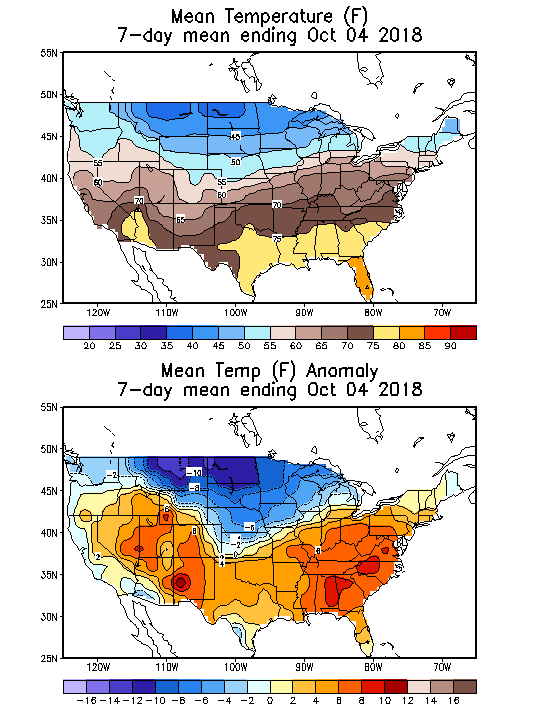
Source: NOAA National Weather Service
Deviation between average and normal (°F)
7-Day Mean ending Oct 04, 2018

Source: NOAA National Weather Service

